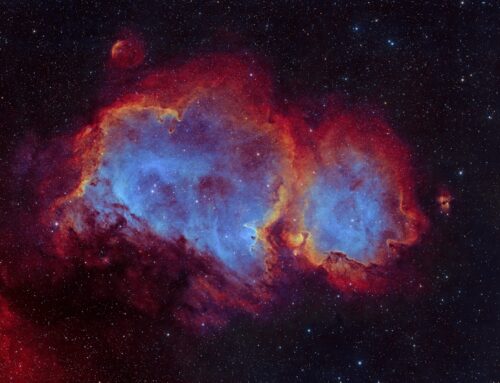Veil Nebula Wide Field (Equipment Test)
 Click image for full size version
Click image for full size version
July 18, 2019
This is the first-light test for two new pieces of equipment: QHY367C one-shot colour camera, and Optolong L-eNhance narrowband filter for colour cameras. The huge sensor on this camera, coupled with the Tak FSQ-106, captures the whole Veil Nebula with room to spare. The L-eNhance filter did a great job under difficult conditions – this image was taken under a nearly-full Moon. I think it would do even better in a darker sky. I am also having an excellent experience using Primaluce Lab’s Eagle 3 Pro computer which is now being used to control everything: two imaging cameras, an autoguider/planetary camera, two focusers and two dew heater strips (see video here).
________________________________________________________________________________________________________
This photo shows the entire Veil Nebula, a supernova remnant in Cygnus the Swan. The Veil Nebula complex is huge, covering about 7 moon widths on the sky. It is so large that it is difficult to capture the whole thing at once, so most of my previous images of this region have focused on individual portions:
- The Eastern Veil Nebula, NGC 6992 is to the upper left of the image.
- The Western Veil Nebula, NGC 6960 (“The Witch’s Broom”) is at centre right.
- Pickering’s Triangle is to the left of the Witch’s Broom.
- NGC 6979 lies above and to the right of the Eastern Veil Nebula.
The supernova that created the Veil Nebula happened between 5000-8000 years ago and the nebula has been expanding ever since. The glowing gas is mostly hydrogen and sulphur (red) and oxygen (teal) whose atoms are being excited by the pressure waves created by the massive explosion of the progenitor star, which was about 1,470 light years from Earth.
The brightest parts of the Veil are visible in modest amateur equipment in a dark sky, especially with an Oxygen-3 (O3) filter, which dramatically enhances contrast. It’s well placed high in the sky in late summer and autumn in the northern hemisphere. The bright star at right in the image, 52-Cygni, is visible with the naked eye and is helpful for finding the nebula. The field is crowded with stars because the nebula lies at the edge of the summer Milky Way.
Tekkies:
Takahashi FSQ-106 ED IV @ f/3.6, QHY367C one-shot colour camera, and Optolong L-eNhance narrowband filter, Paramount MX, unguided. Acquisition, and focusing with TheSkyX. Focus with Optec DirectSync focus motor and controller. Automation with CCDCommander. Equipment control with PrimaLuce Labs Eagle 3 Pro computer. All pre-processing and processing in PixInsight. Acquired from my SkyShed in Guelph. Nearly full Moon, above average transparency and fair seeing. Data acquired July 13-14, 2019.
55x10m with Optolong L-eNhance filter (Total = 9hr10m)
Image scale 2.59 arcsec per pixel
Data Reduction and Cleanup
The BatchPreProcessing script was used to perform calibration, debayering, and registration of all frames. ImageIntegration followed by DrizzleIntegration was used to make the master, which was then cropped. DynamicBackgroundExtraction was applied using Subtraction. RGBWorkingSpace was applied to normalize the channels, and the Luminance was extracted for separate processing.
Colour
Colour Balancing: The colour image was colour balanced with ColorCalibration (note; this did not correct star colours, since this image used a narrowband filter)
Linear Noise Reduction: MultiscaleLinearTransform was used to reduce noise in the background areas, using an internal mask to protect bright structures. Layer settings for threshold and strength: Layer 1: 3.0 0.9 Layer 2: 2.0, 0.75 Layer 3: 1.0, 0.6 Layer 4: 0.5, 0.2.
Stretching: HistogramTransformation was applied to make a pleasing, bright image, with background set to an intensity of approximately 0.10.
Luminance
Deconvolution: StarMask was applied with default settings to produce a Local Deringing Support Image. A clone of the image was stretched to use as a deconvolution mask. Deconvolution was applied (50 iterations, regularized Richardson-Lucy, external PSF made using PSFImage script with 50 stars).
Linear Noise Reduction: MultiscaleLinearTransform was used to reduce noise in the background areas, using an internal mask to protect bright structures. Layer settings for threshold and strength: Layer 1: 3.0 0.9 Layer 2: 2.0, 0.75 Layer 3: 1.0, 0.6 Layer 4: 0.5, 0.2.
Stretching: HistogramTransformation was applied to make a pleasing, bright image, with background set to an intensity of approximately 0.10.
Recombining Luminance and RGB
LRGB Combination: The luminance image was applied to the RGB image using LRGBCombine with default settings.
Additional Processing
Nonlinear Noise Reduction: TGVDenoise was used in L*a*b* mode to reduce noise with a mask used to target the background areas and protect the stars (max. 1000 iterations and convergence selected for both lightness and chrominance).
Sharpening: MultiscaleLinearTransform targeting the lightness channel was used to sharpen Layers 2 and 3 with strengths of 0.05 for both. A mask was used to limit sharpening to the the brightest regions of the nebula.
Final Steps: Background, cluster and star brightness, contrast and colour saturation were adjusted in several iterations using CurvesTransformation with masks as required.






Superb work Ron. Thank you for your introduction to a completely alien Universe for me! Eternally thankful.
https://www.astrobin.com/users/GaryPlum/
Hi Ron, Was wondering if you had a chance to do the experiment you talked about in the VisibleDark video with the L-Pro filter integration for star color?
Not yet. Will post when I do.